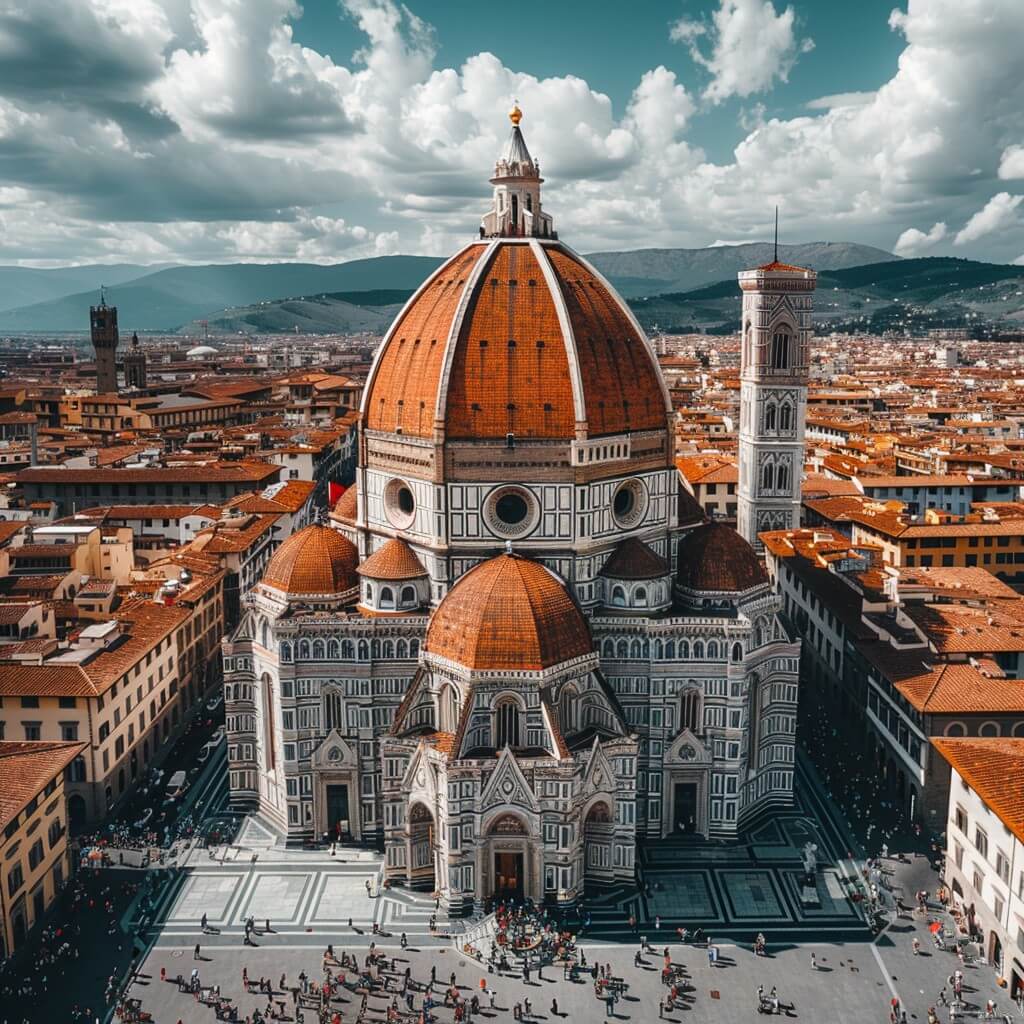
Planning a trip to Tuscany vacation itinerary can be both exciting and overwhelming. With so much to see and do, it’s natural to have a few questions and concerns.
How do you fit in all the major sights without feeling rushed? Are there hidden gems worth visiting that aren’t in every guidebook?
Let’s dive into a detailed 7-day Tuscany vacation itinerary that balances the must-see sights with some lesser-known treasures, all in a friendly, easy-to-follow format.
Day 1: Arrival in Florence
What’s the best way to start my Tuscany vacation itinerary adventure?
Start your Tuscan journey in Florence, the heart of the Renaissance. This city is a treasure trove of art, history, and culture. After settling into your hotel, take a leisurely walk around the city to get your bearings and absorb the atmosphere.
Begin at the Piazza del Duomo, home to the breathtaking Cathedral of Santa Maria del Fiore, known as the Duomo. Its iconic red dome, designed by Brunelleschi, is a must-see. Climb to the top for an unforgettable view of the city.
Next, head to the Piazza della Signoria, a bustling square that serves as an open-air sculpture gallery. Here, you’ll find the Palazzo Vecchio and a replica of Michelangelo’s David.
For the original, visit the Galleria dell’Accademia, where you can marvel at this masterpiece up close. End your day with a stroll along the Ponte Vecchio, a medieval stone bridge lined with jewelry shops.
Personal Tip: Grab a gelato from a local shop like Gelateria dei Neri and enjoy it while sitting in the Piazza della Signoria. It’s a great way to soak in the vibrant atmosphere and people-watch.
Day 2: Florence Continued
How can I make the most of my second day in Florence?
Spend your second day diving deeper into Florence’s rich art and culture. Start your morning at the Uffizi Gallery, one of the most famous art museums in the world.
It houses works by Botticelli, Leonardo da Vinci, and Caravaggio. Make sure to see Botticelli’s “The Birth of Venus” and “Primavera.”
After the Uffizi, take a break at a nearby café before heading to the Pitti Palace and the Boboli Gardens.
The Pitti Palace was once home to the Medici family and now houses several museums. The Boboli Gardens, behind the palace, offer a green oasis with beautiful statues and fountains.
Hidden Gem: For a quieter, equally beautiful experience, visit the Bardini Gardens. They offer stunning views of Florence and are less crowded than the Boboli Gardens.
In the evening, consider crossing the Arno River to the Oltrarno district. This area is known for its artisan workshops, quaint streets, and vibrant nightlife. Have dinner at a local trattoria and enjoy some authentic Tuscan cuisine.
Personal Tip: Try the Bistecca alla Fiorentina, a traditional Florentine steak, paired with a glass of Chianti.
Day 3: Siena
How do I get from Florence to Siena, and what should I see there?
It’s a short drive or train ride from Florence to Siena, a medieval city renowned for its Gothic architecture and the Palio horse race.
Upon arrival, head straight to the Piazza del Campo, the heart of Siena. This unique shell-shaped square is where the Palio takes place twice a year. Climb the Torre del Mangia for panoramic views of the city.
Next, visit the Siena Cathedral (Duomo), one of Italy’s most beautiful churches. Its black-and-white striped façade and intricate interior are breathtaking.
Don’t miss the Piccolomini Library inside, which is adorned with stunning frescoes.
Personal Story: I once stumbled upon a local market in Siena and found the most delicious pecorino cheese. Keep an eye out for these markets—they offer a fantastic glimpse into local life and flavors.
In the afternoon, take a leisurely walk through Siena’s winding streets. Visit the Basilica of San Domenico and the Sanctuary of Saint Catherine, dedicated to Siena’s patron saint.
Hidden Gem: Make your way to the Orto de’ Pecci, a serene garden just outside the city walls. It’s a great spot for a peaceful break and offers beautiful views of the city.
Day 4: Chianti Wine Region
What’s the best way to experience Tuscany’s famous wine region?
No trip to Tuscany vacation itinerary is complete without a day in the Chianti Wine Region. Rent a car and drive through the picturesque vineyards and rolling hills. Start your day in Greve in Chianti, the unofficial capital of the region. Visit the Piazza Matteotti, a charming square surrounded by shops and wine bars. Pop into the Antica Macelleria Falorni for some local cured meats and cheeses.
From Greve, drive to Castellina in Chianti, a quaint village with a rich history. Visit the Rocca di Castellina, a medieval fortress offering stunning views of the countryside. Don’t miss the Etruscan Tombs of Montecalvario, just outside the town.
Must-See: Visit Castello di Brolio, one of the oldest and most famous wineries in Chianti. Take a tour of the castle, learn about the winemaking process, and enjoy a tasting session.
Personal Story: I once had the pleasure of meeting the winemaker at Castello di Brolio, who shared fascinating stories about the vineyard’s history and the Chianti Classico wine. It was an unforgettable experience.
End your day in Radda in Chianti, a small town known for its charming streets and excellent wine shops. Have dinner at a local trattoria and savor a traditional Tuscan meal.

Day 5: San Gimignano and Volterra
Are there any medieval towns worth visiting outside the main cities?
Head to San Gimignano, known for its medieval towers and enchanting atmosphere. Often referred to as the “Manhattan of the Middle Ages,” this town’s skyline is dotted with ancient towers. Begin at the Piazza della Cisterna, a triangular square surrounded by medieval buildings. Climb the Torre Grossa, the tallest tower in San Gimignano, for a breathtaking view of the Tuscan countryside.
Next, visit the Collegiata di Santa Maria Assunta, a Romanesque church with beautiful frescoes. The Museo Civico is also worth a visit for its collection of medieval and Renaissance art.
Personal Tip: For a unique experience, visit the San Gimignano 1300 Museum, which features a detailed miniature model of the town as it was in the 14th century.
After lunch, drive to Volterra, a town with a rich Etruscan history and unique alabaster crafts. Start at the Piazza dei Priori, the main square, and visit the Palazzo dei Priori, the oldest town hall in Tuscany. Explore the Etruscan Museum, which houses a fascinating collection of artifacts, including urns and statues.
Hidden Gem: Don’t miss the Roman Theatre, an ancient site that dates back to the 1st century BC. It’s one of the best-preserved Roman theaters in Italy and offers a glimpse into Volterra’s past.
In the evening, take a stroll through Volterra’s atmospheric streets and enjoy dinner at a local restaurant. Try the wild boar ragù, a regional specialty.
Day 6: Val d’Orcia
What scenic spots should I visit in Tuscany vacation itinerary?
Spend a day in the Val d’Orcia, a UNESCO World Heritage site known for its stunning landscapes. This region epitomizes the picturesque Tuscan countryside, with its rolling hills, cypress trees, and charming villages. Start your day in Pienza, a Renaissance town designed by Pope Pius II. Stroll through the Piazza Pio II and visit the Cathedral of Santa Maria Assunta. Don’t miss the Palazzo Piccolomini, the pope’s former residence, which offers stunning views of the Val d’Orcia.
Personal Tip: Pienza is famous for its pecorino cheese. Visit a local shop for a tasting and bring some home as a delicious souvenir.
From Pienza, drive to Montepulciano, a hilltop town renowned for its Vino Nobile wine. Explore the Piazza Grande, the main square, and visit the Cathedral of Santa Maria Assunta. Make sure to tour a local winery and sample the Vino Nobile di Montepulciano.
Hidden Gem: Take a short hike to the Cypress Grove of San Quirico d’Orcia for postcard-perfect views. This iconic spot is a favorite among photographers and offers a quintessential Tuscan landscape.
In the evening, relax in the thermal baths of Bagno Vignoni, a unique village built around a large, steaming pool. The hot springs have been used since Roman times and provide a perfect way to unwind.
Day 7: Pisa and Lucca
Can I visit Pisa and Lucca in one day?
Yes, you can visit both Pisa and Lucca in a day if you plan accordingly. Start your day in Pisa to see the iconic Leaning Tower. Arrive early to avoid the crowds and climb the tower for a unique perspective of the city.
Next, visit the Cathedral of Santa Maria Assunta and the Baptistery in the Piazza dei Miracoli. This complex is a UNESCO World Heritage site and is one of Italy’s most famous landmarks.
Personal Story: I once took a quirky photo “holding up” the Leaning Tower, a classic tourist shot that’s a fun keepsake. Embrace the tourist spirit and take your own creative photos!
After exploring Pisa, drive to Lucca, a charming town known for its well-preserved Renaissance walls. Walk or bike along the tree-lined walls for panoramic views of the city. Visit the Piazza dell’Anfiteatro, a unique oval square that was once a Roman amphitheater. Explore the San Michele in Foro, a stunning Romanesque church, and the Cathedral of San Martino.
Hidden Gem: Climb the Torre Guinigi, a tower with a unique rooftop garden. The climb is worth it for the incredible views over Lucca and the surrounding countryside.
In the evening, enjoy a leisurely dinner in one of Lucca’s many excellent restaurants. Try the tordelli lucchesi, a type of stuffed pasta that’s a local specialty.
Bonus Tip for Seniors
If you’re someone who enjoys well-paced, guided travel experiences tailored for comfort and ease, consider looking into senior tours in New Zealand as well. Just like Tuscany, New Zealand offers stunning landscapes, rich culture, and thoughtfully curated itineraries—ideal for those who appreciate a relaxed, immersive travel experience.
Conclusion
Tuscany is a region that captivates the heart and ignites the senses. From the art-laden streets of Florence to the serene landscapes of Val d’Orcia, each corner of this enchanting area tells a story steeped in history and culture. This 7-day itinerary offers a balanced blend of must-see attractions and hidden treasures, ensuring you experience the rich tapestry of Tuscan life.
Throughout your journey, you’ll not only immerse yourself in breathtaking sights and delectable cuisine but also connect with the warmth of the local culture. The friendly smiles of the locals, the aromas wafting from bustling trattorias, and the picturesque vineyards invite you to slow down and savor each moment.
As you conclude your trip, remember that Tuscany is not just a destination; it’s an experience that lingers long after you leave. Whether it’s the taste of a local wine, the sight of a breathtaking sunset over the rolling hills, or the sound of laughter echoing in a quaint piazza, these memories will stay with you forever. So take a deep breath, embrace the beauty of Tuscany, and allow its charm to inspire you long after your journey has ended.
Buon viaggio!
Frequently Asked Questions
Is one week enough to explore Tuscany vacation itinerary?
Yes, a week is generally considered sufficient to explore Tuscany’s major highlights and some hidden gems.
This time frame allows travelers to experience the rich culture, art, and cuisine of cities like Florence and Siena, as well as the stunning landscapes of the Val d’Orcia and Chianti regions.
However, if you wish to see more off-the-beaten-path locations or engage in activities like wine tastings, additional time would enhance the experience.
What are the must-see sights in Tuscany?
Key attractions include:
- Florence: Renowned for its Renaissance art and architecture, including the Duomo and Uffizi Gallery.
- Siena: Famous for its medieval cityscape and the historic Piazza del Campo.
- San Gimignano: Known for its medieval towers and beautiful countryside views.
- Val d’Orcia: A UNESCO World Heritage site celebrated for its picturesque landscapes and charming towns like Pienza and Montepulciano.
What is the best way to get around Tuscany?
Renting a car is highly recommended for exploring Tuscany vacation itinerary, especially if you plan to visit smaller towns and rural areas where public transportation may be limited.
A car allows for flexibility in travel times and routes, enabling you to enjoy scenic drives through the countryside.
Alternatively, guided tours or local drivers can be arranged if you prefer not to drive.
What should I include in my itinerary?
A suggested itinerary could be:
- Days 1-2: Explore Florence.
- Day 3: Drive through Chianti to Siena.
- Days 4-5: Discover Siena and the Val d’Orcia region.
- Day 6: Visit San Gimignano and Volterra.
- Day 7: Return to Florence or visit Pisa before departure.
Where should I stay during my trip?
Accommodation options vary widely, from luxury hotels in Florence to agriturismos (farm stays) in the countryside.
Many travelers opt for a mix of stays—spending a few nights in Florence, followed by stays in Siena and the Val d’Orcia—to minimize travel time while maximizing experiences in different locales.
